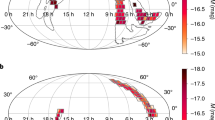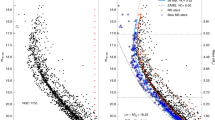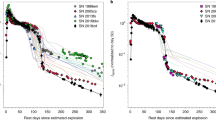Abstract
Binary neutron star mergers are one of the ultimate events of massive binary star evolution, and our understanding of their parent systems is still in its infancy. Upcoming gravitational wave detections, coupled with multi-wavelength follow-up observations, will allow us to study an increasing number of these events by characterizing their neighbouring stellar populations and searching for their progenitors. Stellar evolution simulations are essential to this work, but they are also based on numerous assumptions. Additionally, the models used to study the host galaxies differ from those used to characterize the progenitors and are typically based on single-star populations. Here we introduce a framework to perform an end-to-end analysis and deploy it to the first detected binary neutron star merger event, GW170817. With the Binary Population And Spectral Synthesis codes we are able to retrieve the physical properties of the host galaxy NGC 4993 as well as infer progenitor candidates. In our simulations, there is a >98% chance that GW170817 originated from a stellar population with metallicity Z = 0.010, born between 5 and 12.5 Gyr ago. By carefully weighing the stellar genealogies, we find that GW170817 most likely came from a binary system born with a 13–24 M⊙ primary and 10–12 M⊙ secondary that underwent 2 or 3 common envelope events over their lifetime.
This is a preview of subscription content, access via your institution
Access options
Access Nature and 54 other Nature Portfolio journals
Get Nature+, our best-value online-access subscription
$29.99 / 30 days
cancel any time
Subscribe to this journal
Receive 12 digital issues and online access to articles
$119.00 per year
only $9.92 per issue
Buy this article
- Purchase on Springer Link
- Instant access to full article PDF
Prices may be subject to local taxes which are calculated during checkout



Similar content being viewed by others
Data availability
The LIGO/Virgo posterior distributions are publicly available from https://dcc.ligo.org/LIGO-P1800370/public. The data resulting from the numerical simulations of supernova kicks used to perform this analysis (main text and Supplementary Information) are publicly available at https://doi.org/10.5281/zenodo.7138935.
Code availability
BPASS v.2.2.1 can be found at https://bpass.auckland.ac.nz or https://warwick.ac.uk/bpass. The hoki python package is available on GitHub (https://github.com/HeloiseS/hoki) and published in ref. 18. The data analysis codes used to perform this analysis (main text and Supplementary Information) are publicly available at https://doi.org/10.5281/zenodo.7138935.
References
Eldridge, J. J. et al. Binary Population and Spectral Synthesis version 2.1: construction, observational verification, and new results. Publ. Astron. Soc. Aust. 34, e058 (2017).
Stanway, E. R. & Eldridge, J. J. Re-evaluating old stellar populations. Mon. Not. R. Astron. Soc. 479, 75–93 (2018).
Eggleton, P. P. The evolution of low mass stars. Mon. Not. R. Astron. Soc. 151, 351–364 (1971).
Eldridge, J. J., Izzard, R. G. & Tout, C. A. The effect of massive binaries on stellar populations and supernova progenitors. Mon. Not. R. Astron. Soc. 384, 1109–1118 (2008).
Moe, M. & Di Stefano, R. Mind your Ps and Qs: the interrelation between period (P) and mass-ratio (Q) distributions of binary stars. Astrophys. J. 230, 15 (2017).
Kroupa, P. On the variation of the initial mass function. Mon. Not. R. Astron. Soc. 322, 231–246 (2001).
Belczynski, K., Kalogera, V. & Bulik, T. A comprehensive study of binary compact objects as gravitational wave sources: evolutionary channels, rates, and physical properties. Astrophys. J. 572, 407–431 (2002).
Kruckow, M. U., Tauris, T. M., Langer, N., Kramer, M. & Izzard, R. G. Progenitors of gravitational wave mergers: binary evolution with the stellar grid-based code COMBINE. Mon. Not. R. Astron. Soc. 481, 1908–1949 (2018).
Riley, J. et al. Rapid stellar and binary population synthesis with COMPAS. Astrophys. J. 258, 34 (2022).
Marchant, P. et al. The role of mass transfer and common envelope evolution in the formation of merging binary black holes. Astron. Astrophys. 650, A107 (2021).
Eldridge, J. J., Fraser, M., Smartt, S. J., Maund, J. R. & Crockett, R. M. The death of massive stars. II. Observational constraints on the progenitors of type Ibc supernovae. Mon. Not. R. Astron. Soc. 436, 774–795 (2013).
Steidel, C. C. et al. Reconciling the stellar and nebular spectra of high-redshift galaxies. Astrophys. J. 826, 159 (2016).
Bestenlehner, J. M. et al. The R136 star cluster dissected with Hubble Space Telescope/STIS. II. Physical properties of the most massive stars in R136. Mon. Not. R. Astron. Soc. 499, 1918–1936 (2020).
Stevance, H. F. & Eldridge, J. J. Binary pathways to SLSNe-I: SN 2017gci. Mon. Not. R. Astron. Soc. 504, L51–L55 (2021).
Runco, J. N. et al. The MOSDEF survey: a comprehensive analysis of the rest-optical emission-line properties of z ~ 2.3 star-forming galaxies. Mon. Not. R. Astron. Soc. 502, 2600–2614 (2021).
Stevance, H. F., Parsons, S. G. & Eldridge, J. J. To be or not to be a black hole: detailed binary population models as a sanity check. Mon. Not. R. Astron. Soc. 511, L77–L81 (2022).
Briel, M. M., Eldridge, J. J., Stanway, E. R., Stevance, H. F. & Chrimes, A. A. Estimating transient rates from cosmological simulations and BPASS. Mon. Not. R. Astron. Soc. 514, 1315–1334 (2022).
Stevance, H., Eldridge, J. & Stanway, E. Hoki: making BPASS accessible through Python. J. Open Source Softw. 5, 1987 (2020).
Levan, A. J. et al. The environment of the binary neutron star merger GW170817. Astrophys. J. 848, L28 (2017).
Fong, W., Berger, E. & Fox, D. B. Hubble Space Telescope observations of short gamma-ray burst host galaxies: morphologies, offsets, and local environments. Astrophys. J. 708, 9–25 (2010).
Madau, P. & Dickinson, M. Cosmic star-formation history. Annu. Rev. Astron. Astrophys. 52, 415–486 (2014).
Blanchard, P. K. et al. The electromagnetic counterpart of the binary neutron star merger LIGO/Virgo GW170817. VII. Properties of the host galaxy and constraints on the merger timescale. Astrophys. J. 848, L22 (2017).
Pan, Y. C. et al. The old host-galaxy environment of SSS17a, the first electromagnetic counterpart to a gravitational-wave source. Astrophys. J. 848, L30 (2017).
Im, M. et al. Distance and properties of NGC 4993 as the host galaxy of the gravitational-wave source GW170817. Astrophys. J. 849, L16 (2017).
Bruzual, G. & Charlot, S. Stellar population synthesis at the resolution of 2003. Mon. Not. R. Astron. Soc. 344, 1000–1028 (2003).
Paczynski, B. Common envelope binaries. IAU 73, 75–80 (1976).
Bhattacharya, D. & van den Heuvel, E. P. J. Formation and evolution of binary and millisecond radio pulsars. Phys. Rep. 203, 1–124 (1991).
Tauris, T. M. & van den Heuvel, E. P. J. in Compact Stellar X-ray Sources (eds Lewin, W. & Van der Klis, M.) 623–666 (Cambridge Univ. Press, 2006).
Tauris, T. M. et al. Formation of double neutron star systems. Astrophys. J. 846, 170 (2017).
Vigna-Gómez, A. et al. On the formation history of Galactic double neutron stars. Mon. Not. R. Astron. Soc. 481, 4009–4029 (2018).
Belczynski, K. et al. The origin of the first neutron star—neutron star merger. Astron. Astrophys. 615, A91 (2018).
Chruslinska, M., Belczynski, K., Klencki, J. & Benacquista, M. Double neutron stars: merger rates revisited. Mon. Not. R. Astron. Soc. 474, 2937–2958 (2018).
Mandel, I. & Broekgaarden, F. S. Rates of compact object coalescences. Living Rev. Relativ. 25, 1 (2022).
Ye, C. S. et al. On the rate of neutron star binary mergers from globular clusters. Astrophys. J. 888, L10 (2020).
Belczynski, K. et al. Compact object modeling with the StarTrack population synthesis code. Astrophys. J. 174, 223–260 (2008).
Olejak, A., Belczynski, K. & Ivanova, N. Impact of common envelope development criteria on the formation of LIGO/Virgo sources. Astron. Astrophys. 651, A100 (2021).
Nguyen, C. Status of the advanced Virgo gravitational-wave detector. Preprint at https://doi.org/10.48550/arXiv.2105.09247 (2021).
Cappellari, M. Improving the full spectrum fitting method: accurate convolution with Gauss–Hermite functions. Mon. Not. R. Astron. Soc. 466, 798–811 (2017).
Abbott, B. P. et al. Properties of the binary neutron star merger GW170817. Phys. Rev. X 9, 011001 (2019).
Gao, H. et al. Relation between gravitational mass and baryonic mass for non-rotating and rapidly rotating neutron stars. Front. Phys. 15, 24603 (2020).
Abbott, B. P. et al. GW170817: measurements of neutron star radii and equation of state. Phys. Rev. Lett. 121, 161101 (2018).
Wiringa, R. B., Fiks, V. & Fabrocini, A. Equation of state for dense nucleon matter. Phys. Rev. C 38, 1010–1037 (1988).
Akmal, A. & Pandharipande, V. R. Spin–isospin structure and pion condensation in nucleon matter. Phys. Rev. C 56, 2261–2279 (1997).
Müther, H., Prakash, M. & Ainsworth, T. L. The nuclear symmetry energy in relativistic Brueckner–Hartree–Fock calculations. Phys. Lett. B 199, 469–474 (1987).
Hobbs, G., Lorimer, D. R., Lyne, A. G. & Kramer, M. A statistical study of 233 pulsar proper motions. Mon. Not. R. Astron. Soc. 360, 974–992 (2005).
Acknowledgements
H.F.S. and J.J.E. acknowledge the support of the Marsden Fund Council managed through Royal Society Te Aparangi. H.F.S. is thankful to L. Della Bruna, A. Adamo and C. Usher for private communications regarding the voronoi binning and ppxf algorithms. H.F.S. is grateful to S. Smartt for his comments on the final draft of the manuscript. E.R.S. acknowledges funding from the UK Science and Technology Facilities Council through Consolidated Grant ST/T000406/1. A.J.L. has received funding from the European Research Council under the European Union’s Horizon 2020 research and innovation programme (Grant agreement No. 725246).
Author information
Authors and Affiliations
Contributions
H.F.S. is the lead developer of hoki, created the pipelines to make BPASS SED templates, refactored the TUI codebase, performed the SED fitting and led the writing of this manuscript. J.J.E. conceived the project, is one of the lead developers of BPASS, wrote TUI, advised throughout the analysis and writing process and contributed text to Supplementary Information. E.R.S. is one of the lead developers of BPASS and commented on early and later drafts of the manuscript. J.L. provided relevant expertise on the SED fitting procedure and analysis of NGC 4993 as well as the data reduction used for this paper. A.F.M. advised on the handling of Multi Unit Spectroscopic Explorer data and SED fitting. A.J.L. led the initial acquisition of the data, provided text and advised on the manuscript.
Corresponding author
Ethics declarations
Competing interests
The authors declare no competing interests.
Peer review
Peer review information
Nature Astronomy thanks Matthias Kruckow and the other, anonymous, reviewer(s) for their contribution to the peer review of this work.
Additional information
Publisher’s note Springer Nature remains neutral with regard to jurisdictional claims in published maps and institutional affiliations.
Supplementary information
Supplementary Information
Supplementary Figs. 1–14 and Sections 1–3.
Rights and permissions
Springer Nature or its licensor (e.g. a society or other partner) holds exclusive rights to this article under a publishing agreement with the author(s) or other rightsholder(s); author self-archiving of the accepted manuscript version of this article is solely governed by the terms of such publishing agreement and applicable law.
About this article
Cite this article
Stevance, H.F., Eldridge, J.J., Stanway, E.R. et al. End-to-end study of the host galaxy and genealogy of the first binary neutron star merger. Nat Astron 7, 444–450 (2023). https://doi.org/10.1038/s41550-022-01873-y
Received:
Accepted:
Published:
Issue Date:
DOI: https://doi.org/10.1038/s41550-022-01873-y



